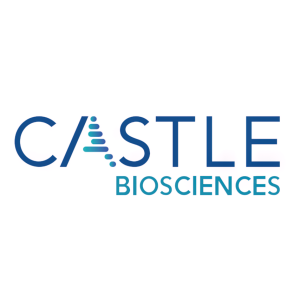DecisionDx®-Melanoma Integrated Test Result Now Includes i31-GEP for Risk of Recurrence
Castle Biosciences (NASDAQ: CSTL) has enhanced its DecisionDx-Melanoma test by integrating the new i31-GEP for Risk of Recurrence (i31-ROR) algorithm. This innovation aims to predict five-year outcomes for melanoma-specific survival, distant metastasis-free survival, and recurrence-free survival, improving treatment precision for patients. The company previously launched i31-SLNB to provide risk assessments for sentinel lymph node positivity. Both algorithms utilize tumor-specific data, with validation from over 5,700 samples, promising better patient management and treatment pathways.
- Introduction of i31-ROR algorithm enhances DecisionDx-Melanoma test, predicting patient-specific five-year outcomes.
- Validated in over 5,700 samples, ensuring reliability and effectiveness in predicting melanoma progression.
- Improved precision in treatment decisions potentially leading to better patient outcomes.
- None.
Insights
Analyzing...
i31-GEP for Risk of Recurrence algorithm integrates DecisionDx-Melanoma score with clinicopathologic factors to provide patient-specific five-year outcomes
DecisionDx-Melanoma is a gene expression profile (GEP) test that uses an individual patient’s tumor biology to predict individual risk of cutaneous melanoma metastasis or recurrence, as well as risk of sentinel lymph node positivity, independent of traditional staging factors, and has been studied in more than 5,700 patient samples.
Earlier this year, Castle launched the ITR for DecisionDx-Melanoma, which included i31-GEP Sentinel Lymph Node Biopsy (i31-SLNB). i31-SLNB is an independently validated algorithm that integrates clinicopathologic features with the 31-GEP score. i31-SLNB is designed to provide a more precise and personalized prediction of sentinel lymph node (SLN) positivity to guide discussions and recommendations, within current risk-based guidelines, for the SLN biopsy (SLNB) surgical procedure.
Castle has now completed independent validation of a new, separate algorithm, i31-ROR, that integrates DecisionDx-Melanoma’s 31-GEP score with the specific Breslow thickness, mitotic rate, SLN status, ulceration status and location (head and neck, extremities, trunk) of the individual patient’s tumor. The additional endpoints of RFS and DMFS, which are not currently provided by the
“Clinicians and patients look to our tests to provide clinically actionable information that better informs cancer management decisions, such as intensity of surveillance and follow-up frequency,” said
“With this additional information, DecisionDx-Melanoma results are not only designed to provide a more precise, personalized likelihood of SLN positivity, but now also include a more individualized risk assessment, rather than an average, population-based risk estimate, that we believe can help personalize patient management decisions and overall risk assessments beyond standard melanoma staging.”
About DecisionDx-Melanoma
DecisionDx®-Melanoma is a gene expression profile test that uses an individual patient’s tumor biology to predict individual risk of cutaneous melanoma metastasis or recurrence, as well as sentinel lymph node positivity, independent of traditional staging factors, and has been studied in more than 5,700 patient samples. Using tissue from the primary melanoma, the test measures the expression of 31 genes. The test has been validated in four archival risk of recurrence studies of 901 patients and six prospective risk of recurrence studies including more than 1,600 patients. Impact on patient management plans for one of every two patients tested has been demonstrated in four multicenter and single-center studies including more than 560 patients. The consistent performance and accuracy demonstrated in these studies provides confidence in disease management plans that incorporate DecisionDx-Melanoma test results.
To predict risk of recurrence and likelihood of sentinel lymph node positivity, the Company utilizes its proprietary algorithms, i31-ROR and i31-SLNB, to produce an integrated DecisionDx-Melanoma test result.
Through
About
Castle also has active research and development programs for tests in other dermatologic diseases with high clinical need, including its test in development to predict systemic therapy response in patients with moderate to severe psoriasis, atopic dermatitis and related conditions.
For more information, visit www.CastleBiosciences.com.
DecisionDx-Melanoma, DecisionDx-CMSeq, DecisionDx-SCC, DecisionDx DiffDx-Melanoma, myPath Melanoma, DecisionDx-UM, DecisionDx-PRAME and DecisionDx-UMSeq are trademarks of
Forward-Looking Statements
The information in this press release contains forward-looking statements and information within the meaning of Section 27A of the Securities Act of 1933, as amended, and Section 21E of the Securities Exchange Act of 1934, as amended, which are subject to the “safe harbor” created by those sections. These forward-looking statements include, but are not limited to, statements concerning DecisionDx-Melanoma’s ability to improve the precision of treatment plans for better patient care, predict patient-specific five-year outcomes for MSS, DMFS and RFS, predict the risk of cutaneous melanoma metastasis or recurrence, as well as the risk of SLN positivity, independent of traditional staging factors, provide a more precise, personalized likelihood of SLNB positivity, a more individualized risk assessment, and help personalize patient management decisions and overall risk assessments beyond standard melanoma staging, and the ability of our i31-SLNB and i31-ROR algorithms to provide a more precise and personalized prediction of SLN positivity and guide discussions and recommendations for the SLNB surgical procedure and help determine the appropriate treatment pathways for each patient’s disease. The words “anticipates,” “believes,” “estimates,” “expects,” “intends,” “may,” “plans,” “projects,” “will,” “would” and similar expressions are intended to identify forward-looking statements, although not all forward-looking statements contain these identifying words. We may not actually achieve the plans, intentions or expectations disclosed in our forward-looking statements, and you should not place undue reliance on our forward-looking statements. Actual results or events could differ materially from the plans, intentions and expectations disclosed in the forward-looking statements that we make. These forward-looking statements involve risks and uncertainties that could cause our actual results to differ materially from those in the forward-looking statements, including, without limitation, the effects of the COVID-19 pandemic on our business and our efforts to address its impact on our business, subsequent study results and findings that contradict earlier study results and findings, DecisionDx-Melanoma’s (and its integrated algorithms) ability to provide the aforementioned benefits to patients and the risks set forth in our Quarterly Report on Form 10-Q for the quarter ended
View source version on businesswire.com: https://www.businesswire.com/news/home/20211028005026/en/
Investor Contact:
832-835-5158
czuckero@castlebiosciences.com
Media Contact:
amarshall@castlebiosciences.com
Source:







